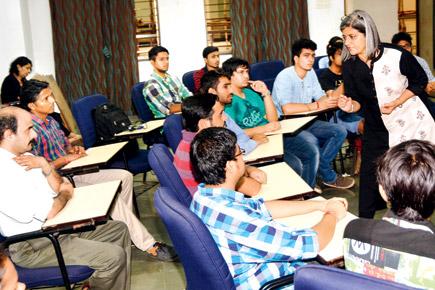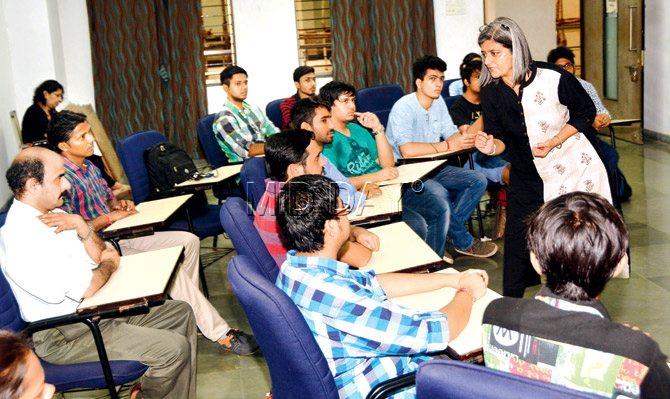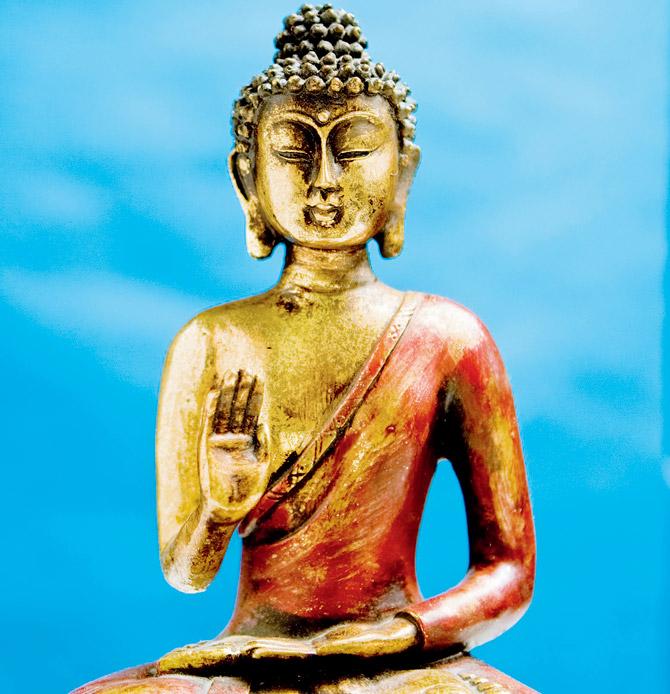Twenty engineering students from a city college are learning to build the world around them with a little help from Buddhist theories

 The arched entrances and the carved chaitya (prayer hall) of the Karla cave complex have evoked curiosity in 20-odd engineering students of the K J Somaiya College of Engineering. They will soon spend three days in Lonavala which will be the base point for their visit to the iconic Buddhist cave trilogy of Karla, Bhaja and Bedse. They will close the loop with a trek to the rock-cut Kondane caves near Karjat, spending a good few hours under the waterfalls on the way to the historically significant Rajmachi village.
The arched entrances and the carved chaitya (prayer hall) of the Karla cave complex have evoked curiosity in 20-odd engineering students of the K J Somaiya College of Engineering. They will soon spend three days in Lonavala which will be the base point for their visit to the iconic Buddhist cave trilogy of Karla, Bhaja and Bedse. They will close the loop with a trek to the rock-cut Kondane caves near Karjat, spending a good few hours under the waterfalls on the way to the historically significant Rajmachi village.
ADVERTISEMENT

The Buddhism for Engineers programme at Dr K J Somaiya College of Engineering is designed and run by Dr Supriya Rai. While it entails students' onsite learning at Buddhist cave sites in Maharashtra to understand the architectural planning that went into rock-cut shrines, students are also to be inducted into a meditation retreat. Pics/Sayyed Sameer Abedi
The excursion has the trappings of an optional monsoon trip. But it is a graded practical in the Buddhism for Engineers programme at the college. The would-be engineers will write a paper on their observations about the architectural finesse and structural planning that went into the carving of the cave sites designed for residence, study and meditation around 2,000 years ago. While marvelling at the multistoried viharas (resting spots), grand pillars, large horseshoe shaped windows, stone carved beds, students will dwell on the long-term planning required for the choice of the sites which coincided with trade routes. In an age where the mind's eye was the reference point, how did the chisel and the hammer give birth to such wonders — this is the prism through which they will grasp the rock-cut heritage of Maharashtra.
While Karla, Bhaja and Bedse is an obviously detailed tour, the Buddhism for Engineers curriculum includes smaller one-day trips to the massive basaltic rock structures carved in Kanheri (located within city limits in Borivli) and the Pandavleni cluster of 24 caves near Nashik. If time permits and student interest remains steady, the Ajanta and Ellora visits are also on the cards, informs an excited Dr Supriya Rai, the course designer and faculty who is also the Acting Director of the K J Somaiya Centre for Buddhist Studies (inaugurated in 1993 by His Holiness, the Dalai Lama), which offers Masters and PhD Research programmes.

Manan Sanghvi
This is the first time that the life and teachings of the Buddha and his analysis of the human mind has been offered as an audit course (as against credit courses, the audit options are beyond the curriculum, but accounted for assessment and attendance) to semester five engineering students. The idea is to see if Buddha's principle of causality — every phenomenon comes into being due to various causes and conditions; when the conditions fall apart, things fall apart — and his theory of interconnectedness of the universe adds value to engineering.
As of now Buddhism has sufficiently animated Rai's students. A typical one-hour weekly lecture starts with a presentation on a key aspect of the Buddhist doctrine, a textual reference to Buddhavacana (the word of the Buddha), followed by interactive exercises which center around mind training. Students are asked to treat the mind as a fundamental aspect of reality, because Buddhism rests on the fact that the observer's mind is a part of the observed reality. Taking recourse to the famous Double Slit experiment in quantum physics, Rai shows how matter and energy become phenomena only when observed.

Explained in terms of photons and electrons floating in the quantum realm, the test underlines the role of the observer in space. To lighten the atmosphere she repeats the "is there a cloud in the paper?" test, each time with students who bunk a lecture. Those who know that the test is about the interconnections in the world (without a cloud, there will be no rain; which means no trees, and no paper and that's why the cloud is a part of the paper) are not supposed to provide clues. The class ends with a promise: the next begins with a joint viewing of the first in the Hollywood Matrix series which deals with simulated reality. As Rai jots down her turn to bring the DVD player to the class, the 20-somethings disperse for their third-year engineering.
Rai's students are disarmingly honest about their non-academic reasons for choosing Buddhism. A few felt it would be "easier" than other audit courses like German/French, time and stress management, data modelling, accounting or welding, some took it "because their friends had enrolled" and some, like Rishi Vasa (pursuing the IT engineering stream), felt Rai's doctoral degree gave him "I am in the right hands" confidence. For Shreyas Kotak, the only declared atheist in the class, this was a choice that went close to his bent of mind. "During a recent Sikkim trip, where I met and spent time with monks, I realised the non-theistic roots of Buddhism, which are close to my belief that the universe has no single Creator."
Irrespective of the reasons, Rai is pleasantly surprised that a bunch of 20-year-olds (from traditional middleclass Hindu and Jain families) chose an academic programme about a religion that they knew only through pop culture references. "Very few students knew anything more than the fact that Buddha was a prince who attained enlightenment under a tree. And, yet, they reposed their faith and time in learning something new. I find that very healthy and unprejudiced... consider this in a world where parents have petitioned governments not to teach Darwin's Evolution," informs Rai. Interestingly, parents of those attending Rai's class are either clueless or uninformed about the Buddhism option. When Komal Patil, seeking the electrical engineering degree, told her father (serving Mumbai police) about her choice of Buddhism, he said "it's okay as long as you do well." Manan Sanghvi, belonging to a Jain family, had apprehensions of how his parents would react.
"They smiled at each other and said: Thank God, if not Jainism, at least you are studying some religion." For Kotak, whose parents are in Akola, the course was a logical extension of a family vacation in Sikkim. Rai feels the students, though under-informed to begin with, were later attracted to the fact they were being trained to relax their minds to debate over core beliefs. They looked upon it as a life skill, considering the pressures of studies. Sarika Navale, a would-be electrical engineer, said "at least there is some course that takes off the pressure." Some students said they were touched by the Dalai Lama's declaration that if science proves any tenet of Buddhism wrong, Buddhism will have to change. "Instead of producing monolith engineers, who are uninfluenced by either the arts or philosophies, it is any day rewarding to expose tomorrow's engineers to an intellectual tradition," explains Rai who maintains that: "Around 2,500 years ago, the Buddha spent 45 years of his life walking up and down in Bihar and eastern UP, explaining his reasoned arguments. He had a huge following in his era. Isn't it high time Indian students knew more about him?"
Buddhism for Engineers is a part of an academic fusion visualised on the Somaiya Vidyavihar campus. "It is a knowledge system that exposes the student to a wider world. Our aim is to widen the student's mind and intellect," says chairman Samir Somaiya who says a creative marriage of Buddhism and other philosophies with the sciences can coax the student to make a better sense of the complex evolving world — a Buddha-like quality.
While long-term plans will evolve, the immediate to-do list includes arrangements to integrate the Buddhist meditation techniques with the theory lectures. Engineers have sought for a retreat (mostly in the Kondhanpur village on the Pune-Satara road) where they can cut themselves off from the routine. A Japanese monk will lead the students in the meditation route. That will be Nirvana engineering!
Sumedha Raikar-Mhatre is a culture columnist in search of the sub-text. You can write to her at sumedha.raikar@gmail.com
 Subscribe today by clicking the link and stay updated with the latest news!" Click here!
Subscribe today by clicking the link and stay updated with the latest news!" Click here!







